Topics
Category
Era
St. Anthony Falls Tunnel Collapse, October 5, 1869
On October 5, 1869, water seeped and then gushed into a tunnel underneath St. Anthony Falls creating an enormous whirlpool. The falls were nearly destroyed. It was years before the area was fully stabilized and the falls were again safe from collapse.
Four years earlier in 1865, four partners, the most prominent of whom were William W. Eastman and John L. Merriam, bought a large portion of Nicollet Island from Hercules Dousman. With the property came long-ignored water rights that the partners wanted to use.
They brought suit against Saint Anthony Falls Water Power Company, which claimed it controlled all water power on the east side of the falls. Eastman, Merriam, and their partners asked that Saint Anthony Falls Water Power Company remove or lower its existing dam so that Nicollet Island water could be used for new development.
A heated court battle followed. Eventually, the parties reached a compromise that preserved the power company's existing dam but allowed Eastman, Merriam, and their partners to dig a tunnel under Hennepin Island and the Mississippi River to the tip of Nicollet Island, to create a tailrace.
Digging began in September 1868. Similar tunnels had been dug through the sandstone on the west side of the river and under Main Street in St. Anthony, so the 1868 project was considered feasible. However, none of the previous projects had excavated under the river.
The tunnel under the river was six-feet square, and work progressed without difficulty for a year, until October 4, 1869. That morning, workers returning from the weekend found water seeping into the tunnel. They thought it would be an easy fix and continued work. However, by noontime, the seep had become a flow, and the workers were forced out of the tunnel with all of their tools, never to return.
The next morning, Tuesday, October 5, the river broke through and the top of the tunnel collapsed. Water scoured the tunnel wider and deeper until the resulting hole was sixteen-and-a-half feet deep and as much as ninety feet wide. By this time, all of the falls were in danger of collapsing into rapids. With them would go all of the region's water power.
By October 5, everyone in the area knew of the growing disaster at St. Anthony Falls. Hundreds of men volunteered to help fill the gaping hole in the rock wall of the falls. First, they threw rocks, dirt, and logs into the hole, only to see them swept away. Next, they constructed two cribs (rafts of logs), weighted them down with rocks, and sunk them into the hole. These worked briefly but eventually were swept away and made the damage worse.
Finally, under the direction of businessman and civic leader George Brackett and the Minneapolis Fire Department, volunteers built three cofferdams to block off the area of the break. Work on these cofferdams continued day and night for weeks until the water was diverted, the break sealed off, and the sandstone erosion lessened. The falls were saved, for the short term.
Further breaks in the sandstone under the falls required more work during the next few years. Eventually, the United States Army Corps of Engineers intervened. The Corps built a full concrete curtain wall and a protective apron before the falls were fully stabilized.
Bibliography
Anfinson, John O. "Spiritual Power to Industrial Might: 12,000 Years at St. Anthony Falls." Minnesota History 58, no. 5 and 6 (Spring/Summer 2003): 252–269.
http://collections.mnhs.org/MNHistoryMagazine/articles/58/v58i05-06p252-269.pdf
"Another Catastrophe!" The Saint Paul Pioneer, October 6, 1869.
"The Break at the Falls." The Saint Paul Pioneer, October 7, 1869.
Carroll, Jane Lamm. Engineering the Falls: The Corps of Engineers' Role at St. Anthony Falls. St. Paul. United States Army Corps of Engineers, St Paul District. 1993–2004.
"The Disaster at the Falls." The Saint Paul Daily Dispatch, October 6, 1869.
Edgar, William C. The Medal of Gold: A Story of Industrial Achievement. Minneapolis: The Bellman Company, 1925.
"The Falls of St. Anthony." Hennepin County History 17, no. 3 (July 1957): 8–9.
Folwell, William Watts. A History of Minnesota. vol. 3. St. Paul: Minnesota Historical Society Press, 1969. First published 1926.
Kane, Lucile M. The Falls of St. Anthony: The Waterfall That Built Minneapolis. St. Paul: Minnesota Historical Society Press, 1987.
Meyer, Herbert W. "History of St. Anthony Falls Water Power Co. and Minneapolis Mill Co." Reprinted from Our Shield (November 1955–March 1956): 80–97.
Pennefeather, Shannon, ed. Mill City: A Visual History of the Minneapolis Mill District. St. Paul: Minnesota Historical Society Press, 2003.
Saint Anthony Falls Rediscovered. Minneapolis: Minneapolis Riverfront Development Coordination Board, 1980.
"The Tunnel Disaster." The Minneapolis Tribune, October 6, 1869.
"The Tunnel Disaster." The Minneapolis Tribune, October 7, 1869.
"The Tunnel Disaster." The Minneapolis Tribune, October 8, 1869.
Walker, T.B. "How Our Famous St. Anthony Falls Were Saved in 1869." Hennepin County History 17, no. 4 (Winter 1958): 12–14.
Related Resources
Primary
G4144.M5:2S15 1869 .B79 4F
Map Collection, Minnesota Historical Society, St. Paul
Description: Brown, E.S., and Franklin Cook. Map showing the mill sites and water power belonging to the St. Anthony Falls Water Power Co., St. Anthony, Jan. 1st, 1869. Chicago Lithographing Co., 1869. Editor's Note: Shows the St. Anthony Falls area and the tunnel before the collapse.
G4144.M5:2S15 1883 .A4
Map Collection, Minnesota Historical Society, St. Paul
Description: Falls of St. Anthony, Minnesota: to accompany annual report, 1883. Shows the St. Anthony Falls area and lingering damage resulting from the tunnel collapse.
Secondary
Anfinson, Scott F. "Archaeology of the Central Minneapolis Riverfront." Minnesota Archaeologist 48, no. 1-2 (1989), 49, no. 1-2 (1990).
———. "Urban Archaeology: The Minneapolis Riverfront." Hennepin History 52, no. 3 (Summer 1993): 4–15.
Petersen, Penny A. and Marjorie Pearson, Hess, Roise and Company. Architecture and Historic Preservation on the Minneapolis Riverfront. Prepared for the Saint Anthony Falls Heritage Board, March 2007.
Web
The St. Anthony Falls Heritage Board.
http://www.mnhs.org/places/safhb/
Related Images
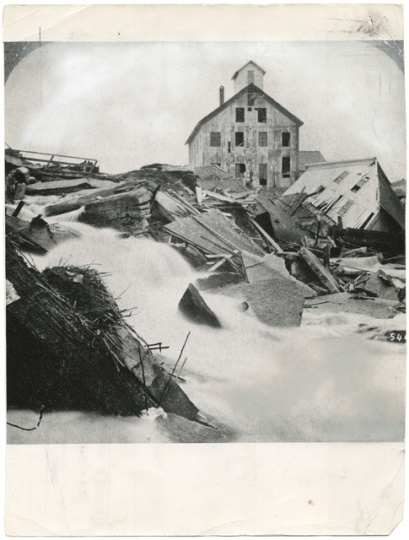
Break in the tunnel, St. Anthony Falls
Break in the tunnel at Saint Anthony Falls, 1869.
Public domain
Holding Location
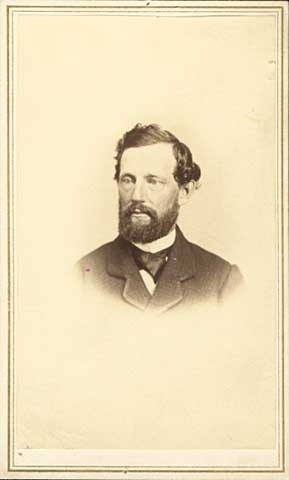
John L. Merriam
John L. Merriam, c.1865, one of the primary people responsible for the tunnel project.
Public domain
Holding Location
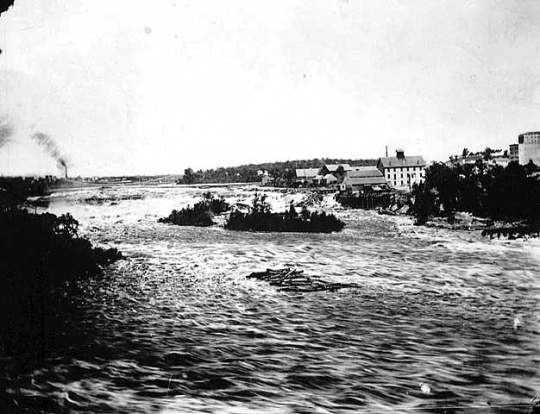
The rapids of St. Anthony in 1869 before break in tunnel
The rapids of Saint Anthony Falls in 1869, as they appeared before the break in the tunnel.
Public domain
Holding Location
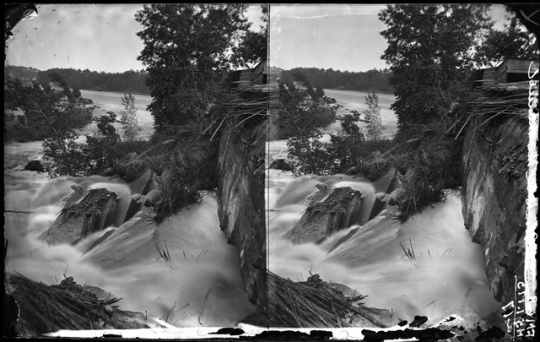
Break in the tunnel at St. Anthony Falls
Break in the tunnel at Saint Anthony Falls, 1869.
Public domain
Holding Location
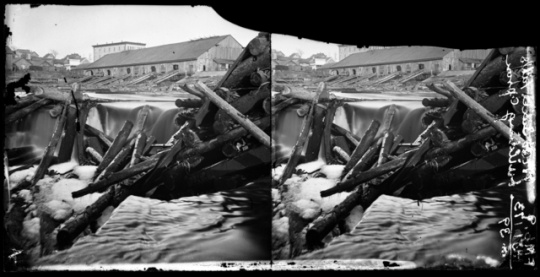
Break in the tunnel at St. Anthony Falls
Break in the tunnel at Saint Anthony Falls, 1869.
Public domain
Holding Location
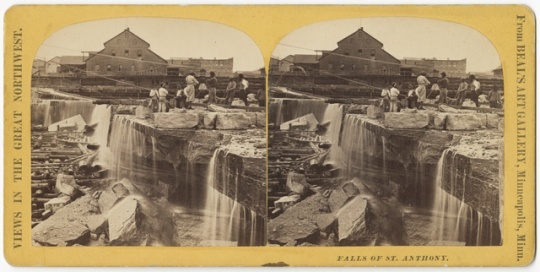
Clean-up crew after tunnel break, St. Anthony Falls, Minneapolis
Clean-up crew after the tunnel break at Saint Anthony Falls, 1869. Photographer: Beal’s Art Gallery.
Public domain
Holding Location
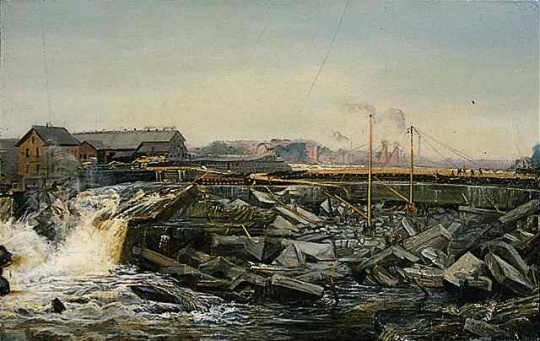
Reconstructing St. Anthony Falls, 1869
Reconstructing St. Anthony Falls, 1869. Oil painting, 1869. Painter: Peter Gui Clausen.
Holding Location
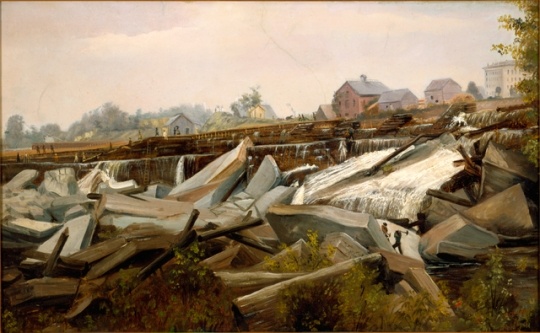
Reconstructing St. Anthony Falls, 1869
Reconstructing St. Anthony Falls, 1869. Oil painting, 1869. Painter: Peter Gui Clausen.
Holding Location
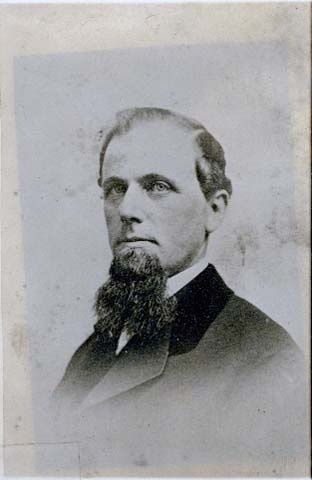
William W. Eastman
William W. Eastman, c.1890, one of the primary people responsible for the tunnel project.
Public domain
Holding Location
Related Articles
Turning Point
In September 1868, digging begins on a six-foot-square tunnel under the Mississippi River, which later leads to the near collapse of St. Anthony Falls.
Chronology
1865
1868
1869
Bibliography
Anfinson, John O. "Spiritual Power to Industrial Might: 12,000 Years at St. Anthony Falls." Minnesota History 58, no. 5 and 6 (Spring/Summer 2003): 252–269.
http://collections.mnhs.org/MNHistoryMagazine/articles/58/v58i05-06p252-269.pdf
"Another Catastrophe!" The Saint Paul Pioneer, October 6, 1869.
"The Break at the Falls." The Saint Paul Pioneer, October 7, 1869.
Carroll, Jane Lamm. Engineering the Falls: The Corps of Engineers' Role at St. Anthony Falls. St. Paul. United States Army Corps of Engineers, St Paul District. 1993–2004.
"The Disaster at the Falls." The Saint Paul Daily Dispatch, October 6, 1869.
Edgar, William C. The Medal of Gold: A Story of Industrial Achievement. Minneapolis: The Bellman Company, 1925.
"The Falls of St. Anthony." Hennepin County History 17, no. 3 (July 1957): 8–9.
Folwell, William Watts. A History of Minnesota. vol. 3. St. Paul: Minnesota Historical Society Press, 1969. First published 1926.
Kane, Lucile M. The Falls of St. Anthony: The Waterfall That Built Minneapolis. St. Paul: Minnesota Historical Society Press, 1987.
Meyer, Herbert W. "History of St. Anthony Falls Water Power Co. and Minneapolis Mill Co." Reprinted from Our Shield (November 1955–March 1956): 80–97.
Pennefeather, Shannon, ed. Mill City: A Visual History of the Minneapolis Mill District. St. Paul: Minnesota Historical Society Press, 2003.
Saint Anthony Falls Rediscovered. Minneapolis: Minneapolis Riverfront Development Coordination Board, 1980.
"The Tunnel Disaster." The Minneapolis Tribune, October 6, 1869.
"The Tunnel Disaster." The Minneapolis Tribune, October 7, 1869.
"The Tunnel Disaster." The Minneapolis Tribune, October 8, 1869.
Walker, T.B. "How Our Famous St. Anthony Falls Were Saved in 1869." Hennepin County History 17, no. 4 (Winter 1958): 12–14.
Related Resources
Primary
G4144.M5:2S15 1869 .B79 4F
Map Collection, Minnesota Historical Society, St. Paul
Description: Brown, E.S., and Franklin Cook. Map showing the mill sites and water power belonging to the St. Anthony Falls Water Power Co., St. Anthony, Jan. 1st, 1869. Chicago Lithographing Co., 1869. Editor's Note: Shows the St. Anthony Falls area and the tunnel before the collapse.
G4144.M5:2S15 1883 .A4
Map Collection, Minnesota Historical Society, St. Paul
Description: Falls of St. Anthony, Minnesota: to accompany annual report, 1883. Shows the St. Anthony Falls area and lingering damage resulting from the tunnel collapse.
Secondary
Anfinson, Scott F. "Archaeology of the Central Minneapolis Riverfront." Minnesota Archaeologist 48, no. 1-2 (1989), 49, no. 1-2 (1990).
———. "Urban Archaeology: The Minneapolis Riverfront." Hennepin History 52, no. 3 (Summer 1993): 4–15.
Petersen, Penny A. and Marjorie Pearson, Hess, Roise and Company. Architecture and Historic Preservation on the Minneapolis Riverfront. Prepared for the Saint Anthony Falls Heritage Board, March 2007.
Web
The St. Anthony Falls Heritage Board.
http://www.mnhs.org/places/safhb/










